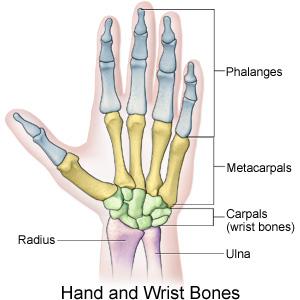Piano Key Sign: Difference between revisions
(Created page with "{{subst:New Page}}") |
(grammar correction, reference added, citations added, info updated) |
||
| (5 intermediate revisions by 2 users not shown) | |||
| Line 1: | Line 1: | ||
<div class="editorbox"> | <div class="editorbox"> | ||
'''Original Editor '''- [[User: | '''Original Editor '''- [[User:Joseph Ayotunde Aderonmu|Joseph Ayotunde Aderonmu]] | ||
'''Top Contributors''' - {{Special:Contributors/{{FULLPAGENAME}}}} | '''Top Contributors''' - {{Special:Contributors/{{FULLPAGENAME}}}} | ||
</div> | </div> | ||
== | == Purpose == | ||
[[File:Hand and wrist bones II.JPG|thumb]] | |||
The piano key sign test is used to assess the stability of the distal radio-ulnar joint (DRUJ)<ref name=":0">Vezeridis PS, Yoshioka H, Han R, Blazar P. [https://scholar.google.com/scholar_url?url=https://link.springer.com/article/10.1007/s00256-009-0775-x&hl=en&sa=T&oi=gsb-ggp&ct=res&cd=0&d=7761175368640555877&ei=2mkGYuXxIbeN6rQP8ZCWsAI&scisig=AAGBfm2MFHJEbLLvNs2Dw7wVvxgKk8YYGQ Ulnar-sided wrist pain. Part I: anatomy and physical examination.] Skeletal radiology. 2010 Aug;39(8):733-45.</ref><ref name=":2">Jawed A, Ansari MT, Gupta V. [https://www.ncbi.nlm.nih.gov/pmc/articles/PMC7384326/pdf/main.pdf TFCC injuries: how we treat?]. Journal of Clinical Orthopaedics and Trauma. 2020 Jul 1;11(4):570-9.</ref><ref>Omokawa S, Iida A, Kawamura K, Nakanishi Y, Shimizu T, Kira T, Onishi T, Hayami N, Tanaka Y. [https://www.ncbi.nlm.nih.gov/pmc/articles/PMC5397311/pdf/10-1055-s-0037-1601367.pdf A biomechanical perspective on distal radioulnar joint instability]. Journal of Wrist Surgery. 2017 May;6(02):088-96.</ref>. | |||
== | == Technique == | ||
In the piano key sign test, the wrist is placed into pronation and the hand is stabilised. Observation of the dorsal [[Ulna|ulnar]] prominence relative to [[radius]] must be done and then the ulnar head must be pushed in a volar direction<ref name=":2" />. | |||
== | === Positive Result === | ||
A positive test occurs when there is minimal resistance felt as the ulnar head displaces in a volar direction<ref name=":2" />. The amount of ulnar volar displacement must be compared on the other side because individuals with generalised [[ligament]] laxity may display a substantial amount of abnormal baseline displacement<ref name=":2" />. The movement of the ulna bears resemblance with when a piano key springs up after the force from a finger is removed from the key, hence the name "piano key" sign<ref name=":1">American Society for Surgery of the Hand. The hand: examination and diagnosis. Churchill Livingstone; 1990.</ref>. | |||
== | === Negative Result === | ||
No instability or movement observed on removal of pressure on the ulnar head. | |||
or | |||
# | == Instructional Video == | ||
{{#ev:youtube|KuFEaWj1Nso}} | |||
== Sensitivity/Specificity == | |||
The piano key sign test has a specificity of 0.96 and a sensitivity of 0.59. <ref>Lindau T, Adlercreutz C, Aspenberg P. [https://scholar.google.com/scholar_url?url=https://www.sciencedirect.com/science/article/pii/S0363502300762782&hl=en&sa=T&oi=gsb&ct=res&cd=0&d=5741249806377052627&ei=6GoGYtGoNYr4yASkqb_4Ag&scisig=AAGBfm3n0zsSEkaiStl7TF4wbn3gLjO5Zg Peripheral tears of the triangular fibrocartilage complex cause distal radioulnar joint instability after distal radial fractures.] The Journal of hand surgery. 2000 May 1;25(3):464-8.</ref> | |||
== References == | == References == | ||
<references /> | <references /> | ||
[[Category:Special Tests]] | |||
Latest revision as of 20:55, 26 July 2023
Original Editor - Joseph Ayotunde Aderonmu
Top Contributors - Joseph Ayotunde Aderonmu, Wendy Snyders and Chelsea Mclene
Purpose[edit | edit source]
The piano key sign test is used to assess the stability of the distal radio-ulnar joint (DRUJ)[1][2][3].
Technique[edit | edit source]
In the piano key sign test, the wrist is placed into pronation and the hand is stabilised. Observation of the dorsal ulnar prominence relative to radius must be done and then the ulnar head must be pushed in a volar direction[2].
Positive Result[edit | edit source]
A positive test occurs when there is minimal resistance felt as the ulnar head displaces in a volar direction[2]. The amount of ulnar volar displacement must be compared on the other side because individuals with generalised ligament laxity may display a substantial amount of abnormal baseline displacement[2]. The movement of the ulna bears resemblance with when a piano key springs up after the force from a finger is removed from the key, hence the name "piano key" sign[4].
Negative Result[edit | edit source]
No instability or movement observed on removal of pressure on the ulnar head.
Instructional Video[edit | edit source]
Sensitivity/Specificity[edit | edit source]
The piano key sign test has a specificity of 0.96 and a sensitivity of 0.59. [5]
References[edit | edit source]
- ↑ Vezeridis PS, Yoshioka H, Han R, Blazar P. Ulnar-sided wrist pain. Part I: anatomy and physical examination. Skeletal radiology. 2010 Aug;39(8):733-45.
- ↑ 2.0 2.1 2.2 2.3 Jawed A, Ansari MT, Gupta V. TFCC injuries: how we treat?. Journal of Clinical Orthopaedics and Trauma. 2020 Jul 1;11(4):570-9.
- ↑ Omokawa S, Iida A, Kawamura K, Nakanishi Y, Shimizu T, Kira T, Onishi T, Hayami N, Tanaka Y. A biomechanical perspective on distal radioulnar joint instability. Journal of Wrist Surgery. 2017 May;6(02):088-96.
- ↑ American Society for Surgery of the Hand. The hand: examination and diagnosis. Churchill Livingstone; 1990.
- ↑ Lindau T, Adlercreutz C, Aspenberg P. Peripheral tears of the triangular fibrocartilage complex cause distal radioulnar joint instability after distal radial fractures. The Journal of hand surgery. 2000 May 1;25(3):464-8.







